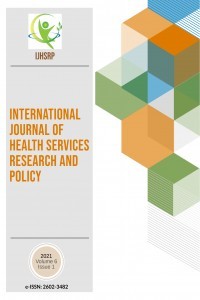DETERMINATION OF GENDER PERCEPTIONS OF NURSING AND MIDWIFERY STUDENTS
DETERMINATION OF GENDER PERCEPTIONS OF NURSING AND MIDWIFERY STUDENTS
student nursing, midwifery, gender perception,
___
- [1] Kömürcü, N., et al., “Attitudes of nursing and midwifery students about gender roles and the perceptions of honor related to women”, International Refereed Journal of Gynaecological Diseases and Maternal Child Health, 3(5), 1-22, 2016. Doi: 10.17367/JACSD.2016516856
- [2] Öngen, B., and Aytaç, S., “Attitudes of university students regarding to gender roles and relationship with life values”, Istanbul Journal of Sociological Studies, 48, 1-18, 2013.
- [3] Dökmen, Y. Z., Toplumsal cinsiyet-sosyal psikolojik açıklamalar. Remzi Kitabevi, İstanbul, 2016.
- [4] Powell, G. N., and Greenhaus, J. H., “Sex, gender, and decisions at the family-work interface”, Journal of Management, 36(4), 1011-1039, 2010. Doi: 10.1177/0149206309350774
- [5] Özkan, D. “The transformation in social gender and roles of women in modern social life: Traditions versus modernity”, Turkish Studies-International Periodical For The Languages, Literature an History of Turkish or Turkic, 9(2), 1239-1252, 2014.
- [6] Pesen, A., et al., “Examining university students’ perceptions of gender and their conflict and violent awareness levels”, International Journal of Society Researches, 6(11), 325-340, 2016.
- [7] Vefikuluçay, D., et al., “Perception of and views on gender roles of senior students enrolled at Kafkas University”, Journal of Hacettepe University School of Nursing, 26-38, 2007.
- [8] Azuh, D., Fayomi, O., Ajayi, L. (2015). “Socio-cultural factors of gender roles in women’s healthcare utilization in Southwest Nigeria”, Open Journal of Social Sciences, 3, 105-117, 2015. Doi: 10.4236/jss.2015.34013
- [9] Aktaş, S., and Çalık, K. Y., “Female genital mutilation”, STED, 19(1), 30-37, 2010.
- [10] Altınova, H. H., & Duyan, V., “The validity and reliability of perception of gender scale”, Journal of Society & Social Work, 24(2), 9-22, 2013.
- [11] Zeyneloğlu, S., and Terzioğlu, F., “Development and psychometric properties gender roles attitude scale”, Hacettepe University Journal of Education 40(40), 409-420, 2011.
- [12] The Global Gender Gap Report. http://www3.weforum.org/docs/WEF_GGGR_2018.pdf
- [13] Alabaş, R., Akyüz, H. I., Kamer, S. T., “Determination of gender perceptions of undergraduates”, Mustafa Kemal University Journal of Social Sciences Institute, 16(44), 429-448, 2019.
- [14] Bakır, N., Irmak Vural, P., Demir, C., “Investigation of unıversity students' attitudes towards sexual education and gender perception in some variables”, Life Skills Journal of Psychology, 3(5), 119-128, 2019. Doi:10.31461/ybpd.548926
- [15] Erbil, N., “Relationship between life values and gender roles attitudes of university students”, Ordu University Journal of Nursing Studies, 2(1), 33-45, 2019.
- [16] Özpulat, F., and Özvarış, Ş. B., “The determination of the self-efficacy levels and gender perception among the students of the Akşehir School of Health”, STED, 28(2), 98-107, 2019. Doi: 10.17942/sted.431011.
- [17] Özpulat, F., “The relationship between nursing students’ violent tendencies and gender perceptions”, BÜSBİD, 2(2), 151-161, 2017.
- [18] Esen, E., et al., “Examination of gender perception of university students according to sex and sex roles”, E-Uluslararası Eğitim Araştırmaları Dergisi, 8(1), 46-63, 2017. Doi: 10.19160/5000197327
- [19] Uçtu, A. K., and Karahan, N., “Analysis of the Relation between gender roles, social gender perception of the Health College students and their violence tendency”, Journal of the Human and Social Sciences Researches, 5(8), 2882-2905, 2016.
- [20] Kabasakal, Z., and Girli, A. “An investigation of views and experiences of university students regarding violence against women in terms of several variables and their relation with students’ life satisfaction (DEU, Buca Faculty of education sample)”, DEU Journal of GSSS, 14(2), 105-123, 2017.
- [21] Vefikuluçay Yılmaz, D., et al., “Views on gender roles of university students”, Journal of Human Sciences, 6(1), 775-792, 2009.
- [22] Balcı Akpınar, R., et al., “Childhood abuse experiences, gender perceptions, violence tendencies and violenit situations of university students”, Atatürk University Journal of Faculty of Letters 62, 409-430, 2019.
- [23] Köken Durgun, S., and Cambaz Ulaş, S. “Determination of attitudes of midwifery/nursing students towards social gender roles”, Medical Sciences (NWSAMS,) 14(2), 93-103, 2019. Doi: 10.12739/NWSA.2019.14.2.1B0069
- [24] Gönenç, İ. M., et al., “Effect of gender course on gender perception”, Journal of Ankara Health Science, 7(1), 22-29, 2018.
- [25] Uzun, Z., et al., “The effect of education on gender perception and gender role attitudes: An experimental study”, Journal of Human Sciences, 14(1), 678-693, 2017. Doi: 10.14687/jhs.v14i1.4354
- [26] Çelik, A. S., et al., “Determination of university students’ attitudes about gender equality”, Florence Nightingale Journal of Nursing, 21(3), 181-186, 2013.
- [27] Kavuran, E., Determination perspectives on gender equality of the students of Health Science at Atatürk University. Master’s Thesis, Atatürk University, Erzurum, Turkey, 2011.
- [28] Atış, F., Attitudes of Determine 1st and 4th Class of Midwifery/Nursing Students' Regarding to Gender Roles. Master’s Thesis, Çukurova University, Adana, Turkey, 2010.
- [29] Turan, Z., Aydın, Y., Toker, E., “Examination on the effect of gender perception of nursing students of “Women’s Health and Diseases Nursing Course”, Journal of Human Sciences, 14(3), 2677-2687, 2017. Doi: 10.14687/jhs.v14i3.4693
- [30] Zeyneloğlu, S., Attitudes of nursing students enrolled at universities in Ankara towards gender roles. Ph. D. Thesis, Hacettepe University, Ankara, Turkey, 2008.
- [31] Kahraman, L., et al., “Nevşehir Hacı Bektaş Veli University gender perception research”, Turkish Studies-International Periodical For The Languages, Literature and History of Turkish or Turkic, 9(2), 811-831, 2014.
- [32] Kodan, S., Investigation of the relationship between marrital quality, attitudes towards gender roles and life satisfaction among the married individual. Master’s Thesis, Atatürk University, Erzurum, Turkey, 2013.
- Yayın Aralığı: Yılda 3 Sayı
- Başlangıç: 2016
- Yayıncı: Rojan GÜMÜŞ
Tuba KOÇ ÖZKAN, Maksude YILDIRIM, İbrahim BUCAK, Habip ALMIŞ
KOLORTA NURSING ATTITUDE SCALE VALIDITY AND RELIABILITY STUDY
Yalçin KANBAY, Elif IŞIK, Özgür ASLAN, Pınar TEKTAŞ, Aysun AKÇAM
DOES PROFESSIONAL VITALITY OF HEALTH CARE WORKERS CHANGE THEIR LEARNED HELPLESSNESS?
Hilal KUŞCU KARATEPE, Fatma Nuray KUŞCU, Ebru GÖZÜYEŞİL
Emine KAPLAN SERİN, Semra BÜLBÜLOĞLU
Dilek ATİK, Basar CANDER, Cesareddin DİKMETAŞ, Serkan DOGAN, İbrahim ÇALTEKİN, Levent ALBAYRAK, Emre GÖKÇEN, Bensu BULUT
EXAMINATION OF NURSING STUDENTS' ACCEPTANCE LEVELS FOR AESTHETIC SURGERY AND AFFECTING FACTORS
Esra TURAL BÜYÜK, Nihal ÜNALDI BAYDIN, Özge DÖRAL
Funda TOSUN GÜLEROĞLU, Gökçen AYDIN AKBUGA, Dilek EFE ARSLAN, Esin CERİT, Aybike BAHÇELİ
